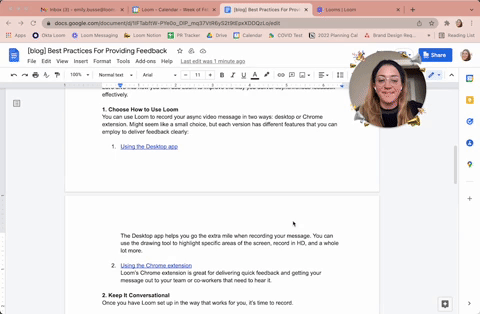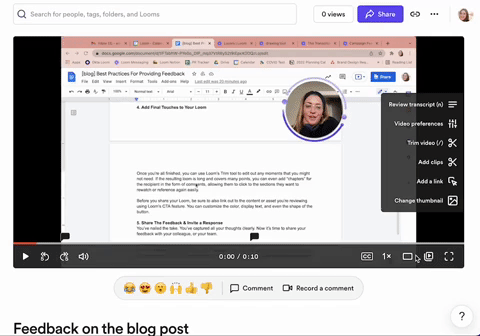Best Practices for Providing Feedback via Loom
Async video can be such a powerful medium for delivering feedback at work. Using tools like Loom, you can preserve the nuanced details—like facial expressions, tone of voice, and body language—that all have a major impact on the way your message is received and interpreted.
Providing feedback at work is a critical ingredient for team development and productivity. Positive and constructive feedback helps individuals feel seen and facilitates their career growth.
At the team level, a clear feedback process improves morale and accelerates productivity. Yet, 65 percent of employees say they want more constructive feedback, and less than 30 percent say they get valuable feedback.
The factors that contribute to feedback being perceived as valuable are complex. When you’re tasked with delivering feedback, it can often feel daunting. You’re likely concerned with striking the right tone, as well as delivering specific information clearly. When you’re face-to-face with a coworker, it’s often easier to convey the right details as well as the tone of your message itself. But, when we try to convert those critical elements into text, the risk that tone, content, and meaning being misconstrued skyrockets.
That’s why asynchronous video can be such a powerful medium for delivering feedback at work. Using tools like Loom, you can preserve the nuanced details—like facial expressions, tone of voice, and body language—that all have a major impact on the way your message is received and interpreted. Video is also a faster, more efficient, and more compelling channel to use to communicate when compared to written text. People who watch a video remember 95 percent of the message versus only 10 percent when having read it.
If you’re tasked with delivering feedback remotely, we often default to live video conferencing. However, there are more than a few good reasons why async video feedback might be the best choice:
- Flexibility: If you are delivering feedback to someone who lives in a different country, you might opt to use async video so they can watch it and digest it at a time that works best for them.
- Complexity: If the feedback is highly complex, using async video allows you to screenshare with multiple assets, draw on the screen, embed links, etc. It also allows your recipient to rewatch your Loom and read the transcript for clarity.
- Efficiency: Perhaps you just need to deliver quick, transactional feedback on version 5 of a project. Or, you need to deliver feedback to a team of several people all at once. Async video can speed up that process without requiring live time from everyone.
Let’s dive into how you can use Loom to improve the way you deliver asynchronous feedback effectively.
1. Choose How to Use Loom
You can use Loom to record your async video message in two ways: desktop or Chrome extension. Might seem like a small choice, but each version has different features that you can employ to deliver feedback clearly:
Using the Desktop app
The Desktop app helps you go the extra mile when recording your message. You can use the drawing tool to highlight specific areas of the screen, record in HD, and a whole lot more. Features like the drawing tool, can help make your feedback more engaging and clear, such as using it to draw attention to a specific piece of information.

Using the Chrome extension
Loom’s Chrome extension is great for delivering quick feedback and getting your message out to your team or co-workers that need to hear it. If external partners get a loom from you, they can use the chrome extension for free to respond in a loom of their own.
2. Keep It Personal
Once you have Loom set up in the way that works for you, it’s time to record. One helpful tip to remember when using async video to deliver feedback is that you’re starting a conversation, not writing a formal email. Picture the way you would deliver this feedback if you were in person. You’d probably smile, say hi, and make a little conversation first. Perhaps you’d also mix in positive feedback along with the constructive points. Do that via Loom as well. Avoid using overly formal language or jumping directly into negative comments without any context or greetings.

This isn’t about glossing over negative feedback, but rather about creating an environment in which your viewer feels respective, receptive, engaged, and encouraged to respond.
3. Keep it Clear & Concise
Let’s say you’re an editor delivering feedback to a writer who has just finished a blog post for you. You’re all set to record your Loom, but you’d like to make sure you stay on track when going through your punch-ups to the writer’s blog post. If you’re like me, rambling happens.
There are easy two tips to make sure your feedback stays on-track. One is to record your screen and highlight the specific paragraphs you’d like to touch on, using the pause button in between. That way the writer knows exactly what area of their work you’re focusing on and pausing gives yourself time to prepare your next point.
Another tip is to prepare your talking points in advance and then use custom dimensions to ensure Loom only records the portion of your screen that you’d like your recipient to see. Think of this as analogous to a presenter view while delivering slides, but for async video. This way, you can keep your notes up alongside the work you’re discussing to stay on track.
4. Add Final Touches to Your Loom
Once you’re all finished, you can use Loom’s Trim tool to edit out any moments that you might not need. If the resulting loom is long and covers many points, you can even add “chapters” for the recipient in the form of comments, allowing them to click to the sections they want to rewatch or reference again easily.

Before you share your Loom, be sure to also link out to the content or asset you’re reviewing using Loom’s CTA feature. You can customize the color, display text, and even the shape of the button.
5. Share the Feedback & Invite a Response
You’ve nailed the take. You’ve captured all your thoughts clearly. Now it’s time to share your feedback with your colleague, or your team.
Make sure to title your Loom appropriately and add additional context or links in the notes section if needed. If this is a 1:1 piece of feedback, you may not want to publish it. But if this is something that is useful for many people on your team, consider publishing to your workspace.
Then, you can use the Share feature to send it via a link or email. If you share it in Slack, the Loom will automatically unfurl under your message so the recipient can view it immediately with a click. And if they have any critique of their own, viewers can use the “record a comment” button to record a Loom in response.
There will, of course, be times when a live conversation is best for delivering feedback. But often, a recorded video may offer a more flexible, scalable, efficient way to move a project forward. By using these tips, you can help keep the flow of communication and collaboration moving—even on globally distributed teams.
